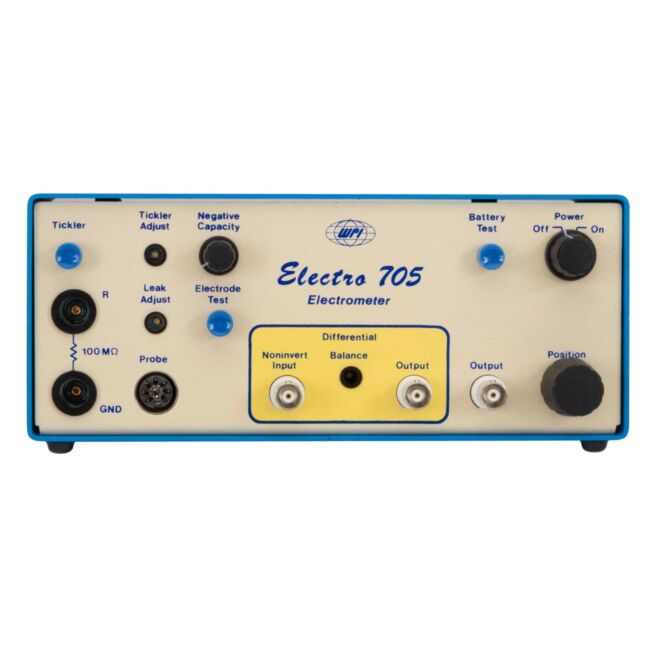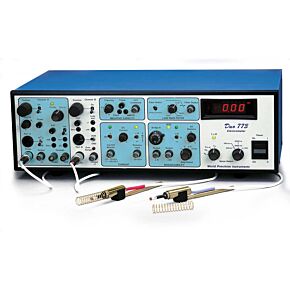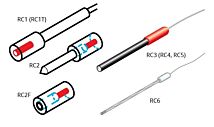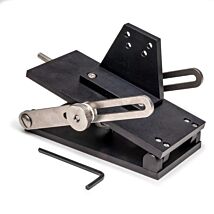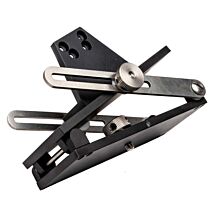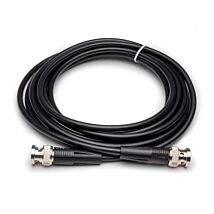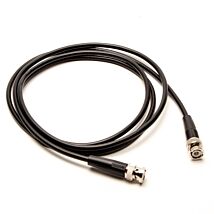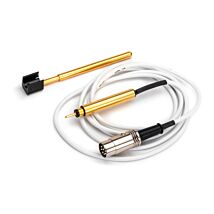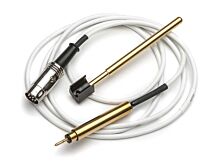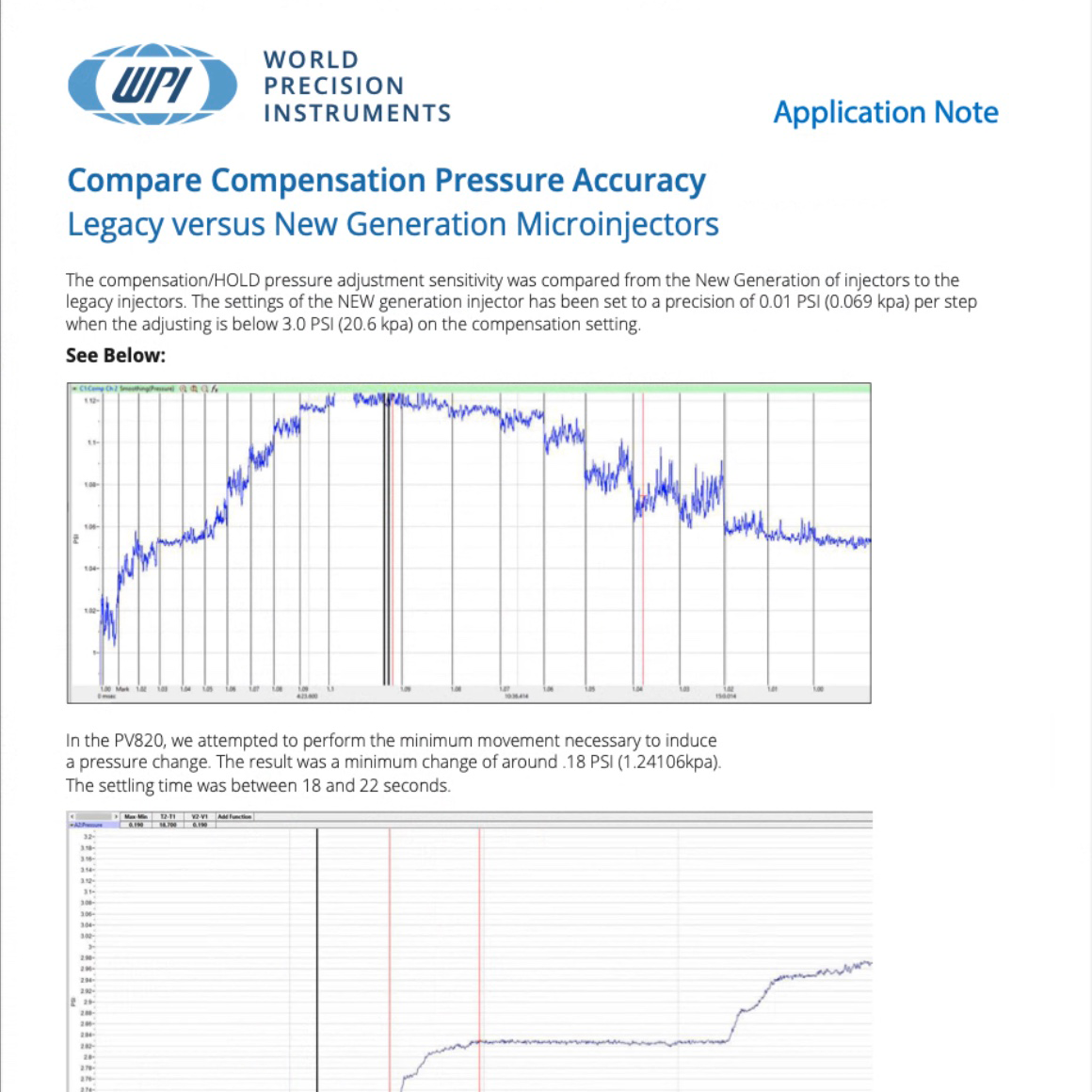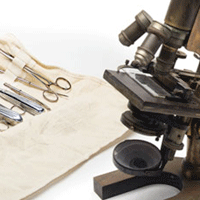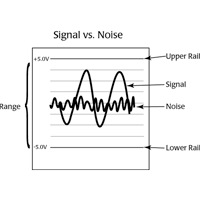This website uses cookies to ensure you get the best experience on our website.
Read more
AMPLIFIER, ELECTROMETER W/PROBE
$2,800.00
Prices valid in USA, Canada, and PR only.
Order code
SYS-705

Prices valid in USA, Canada, and PR only.
High quality, intracellular amplifier perfect for students
Electro 705, a battery operated, low noise, wide band electrometer preamplifier, is designed for intracellular voltage measurement. Two 705’s can be linked together to form a high impedance differential electrometer pair. Each instrument includes a miniature gold plated active probe to which a microelectrode can be attached using the WPI microelectrode holder supplied.
Prices valid in USA, Canada, and PR only.
See what you need to know before you buy an amplifier.
Features
- Driven guard shield
- Test port
- Ground port
- Portable
- Remote headstage
Benefits
- Cost effective
- Battery powered
- Capacitance compensation
Applications
- Measure intracellular action potentials
Electro 705 comes with 1 each of Microelectrode Holder : MEH1SF10, MEH1SF12, MEH1SF15 and MEH1SF20. The RC1T is recommended for reference electrode.
Electro 705, a battery operated, low noise, wide band electrometer preamplifier, is designed for intracellular voltage measurement. Two 705’s can be linked together to form a high impedance differential electrometer pair. Each instrument includes a miniature gold plated active probe to which a microelectrode can be attached using the WPI microelectrode holder supplied.
Remote headstage
Easily mounted in any manipulator, this compact probe, containing the first stage of amplification, includes a microelectrode holder, which plugs directly into the probe input.
Battery power
Four 9V alkaline batteries (included) power the Electro 705 for approximately 500 hours giving a clean, low noise source of power, making the Electro 705 the quietest amplifier available. Batteries can be easily tested by the press of a button.
Capacitance compensation
Corrects for loss of rise time caused by the presence of electrode capacity. Up to 50 pF of electrode shunt capacity may be neutralized.
Driven guard shield
Stray capacitance can be further reduced by placing the driven guard shield (included) over the microelectrode holder at the input end of the probe.
Test features
A Tickler Circuit offers a momentary oscillation that helps achieve cell penetration. The Electo 705 provides a 1 nA electrode test current. Electrode resistance is monitored at the 1X output as a voltage (1 mV/M). The Probe Test Port allows the convenience of testing the amplifier's intrinsic noise and gain without cumbersome external test hookups. Head stage leakage current can also be adjusted with minimum effort. The Baseline Position Control adds or subtracts up to 300 mV to the headstage output, allowing artifact voltages such as liquid junction potentials to be nulled prior to recording.
Differential output
Two Electro 705 units can be connected in tandem to create an optional differential amplifier probe system.
| SKU | SYS-705 |
|---|
| Input Impedance | 1012 Ω, shunted by 1pF |
| Output Impedance | 100 Ω, both outputs |
| Gain | X1: ±0.1% |
| Input Voltage Range | ±5 V |
| Risetime | 15 µs, 10-90% |
| Noise Level | 500 μV peak-to-peak* |
| Input Capacitance Compensation | 0-50 pF |
| Gate Leakage Curent | ±10 pA, adjustable to zero |
| Electrode Resistance Test | 1 mV/MΩ |
| DC Positioning | ±300 mV |
| Common Mode Rejection | >104 (in differential mode) |
| Power | Four 9 V alkaline batteries, supplied |
| Dimensions | 8.5 x 3.5 x 2.2 in. (22 x 9 x 6 cm) |
| Shipping Weight | 5 lb. (2.3 kg) |
Wan, E., Kushner, J. S., Zakharov, S., Nui, X.-W., Chudasama, N., Kelly, C., … Marx, S. O. (2013). Reduced vascular smooth muscle BK channel current underlies heart failure-induced vasoconstriction in mice. FASEB Journal : Official Publication of the Federation of American Societies for Experimental Biology, 27(5), 1859–67. http://doi.org/10.1096/fj.12-223511
Gokina, N. I., Bonev, A. D., Gokin, A. P., & Goloman, G. (2013). Role of impaired endothelial cell Ca2+ signaling in uteroplacental vascular dysfunction during diabetic rat pregnancy. American Journal of Physiology - Heart and Circulatory Physiology, 304(7).
Thomas, R. C., & Bers, D. M. (2013). How to make calcium-sensitive minielectrodes. Cold Spring Harbor Protocols, 2013(4), 370–3. http://doi.org/10.1101/pdb.prot072850
Kinoshita, H., Matsuda, N., Iranami, H., Ogawa, K., Hatakeyama, N., Azma, T., … Yamazaki, M. (2012). Isoflurane Pretreatment Preserves Adenosine Triphosphate–Sensitive K+ Channel Function in the Human Artery Exposed to Oxidative Stress Caused by High Glucose Levels. Anesthesia & Analgesia, 115(1), 54–61. http://doi.org/10.1213/ANE.0b013e318254270d
Haba, M., Kinoshita, H., Matsuda, N., Azma, T., Hama-Tomioka, K., Hatakeyama, N., … Hatano, Y. (2009). Beneficial Effect of Propofol on Arterial Adenosine Triphosphate-sensitive K+ Channel Function Impaired by Thromboxane. Anesthesiology, 111(2), 279–286. http://doi.org/10.1097/ALN.0b013e3181a918a0
Zheng, J., & Pollack, G. H. (2006). Solute Exclusion and Potential Distribution Near Hydrophilic Surfaces. In Water and the Cell (pp. 165–174). Dordrecht: Springer Netherlands. http://doi.org/10.1007/1-4020-4927-7_8
Peters, O., Back, T., Lindauer, U., Busch, C., Megow, D., Dreier, J., & Dirnagl, U. (1998). Increased Formation of Reactive Oxygen Species After Permanent and Reversible Middle Cerebral Artery Occlusion in the Rat, 18(2), 196–205. http://doi.org/10.1097/00004647-199802000-00011


